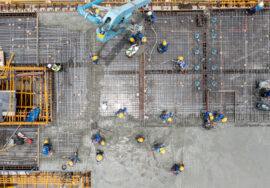How to Manage Human Resource Risks in Construction
How to Manage Human Resource Risks in Construction

Manage Human Resource Risks in Construction” Managing human resources is a critical aspect of construction project management. The nature of construction projects requires a diverse workforce, skilled labor, and efficient communication. However, human resource risks—such as labor shortages, skill mismatches, safety concerns, and high turnover rates—can significantly impact project timelines, costs, and overall success. This blog will explore effective strategies for managing human resource risks in construction, ensuring smoother project execution and better outcomes.
Understanding Human Resource Risks in Construction
What are Human Resource Risks?
Human resource risks in construction refer to potential challenges related to workforce management that could hinder project progress. These risks can arise from various factors, including:
- Labor Shortages: Difficulty in finding skilled labor can lead to project delays.
- Safety Concerns: Construction sites are hazardous; inadequate safety measures can result in accidents and injuries.
- High Turnover Rates: Frequent staff changes can disrupt project continuity and increase training costs.
- Skill Mismatches: Employing workers without the necessary skills can compromise project quality and efficiency.
Strategies to Manage Human Resource Risks
1. Conduct a Comprehensive Workforce Assessment
Before starting a construction project, it is crucial to conduct a thorough assessment of the required workforce. This includes identifying the necessary skills, certifications, and experience levels for various roles. By understanding the specific human resource needs, project managers can proactively address potential skill gaps and plan recruitment strategies accordingly.
2. Develop a Strong Recruitment Strategy
Attracting the right talent is essential for mitigating human resource risks. Develop a recruitment strategy that focuses on:
- Targeted Job Descriptions: Clearly define the skills and experience required for each position.
- Diverse Recruitment Channels: Utilize various platforms, such as job boards, social media, and industry-specific networks, to reach a broader audience.
- Incentives and Benefits: Offer competitive salaries, benefits, and opportunities for professional growth to attract skilled labor.
3. Implement Effective Training and Development Programs
Investing in employee training and development is crucial for minimizing skill mismatches and enhancing workforce capabilities. Consider implementing:
- Onboarding Programs: Provide comprehensive training for new hires to ensure they understand project expectations, safety protocols, and company culture.
- Continuous Learning Opportunities: Encourage ongoing professional development through workshops, certifications, and skills training to keep employees updated on industry trends and best practices.
4. Prioritize Safety and Well-Being
Safety is a paramount concern in construction. To mitigate human resource risks associated with safety, project managers should:
- Implement Safety Training: Conduct regular safety training sessions to educate employees about potential hazards and safe work practices.
- Establish a Safety Culture: Foster a culture of safety where employees feel empowered to report unsafe conditions without fear of retaliation.
- Regular Safety Audits: Conduct regular audits to identify and address safety issues promptly, ensuring compliance with regulations and standards.

Manage Human Resource Risks in Construction
5. Foster Open Communication
Effective communication is essential for managing human resource risks. Implement strategies to promote open dialogue among team members, such as:
- Regular Meetings: Hold regular team meetings to discuss project updates, address concerns, and encourage collaboration.
- Feedback Mechanisms: Create avenues for employees to provide feedback on workplace conditions and management practices, ensuring their voices are heard.
6. Monitor and Manage Employee Performance
Regularly monitoring employee performance can help identify potential issues before they escalate. Consider implementing:
- Performance Reviews: Conduct periodic performance evaluations to provide constructive feedback and recognize employee contributions.
- Succession Planning: Identify high-potential employees and prepare them for leadership roles to ensure project continuity and reduce turnover risks.
7. Build a Positive Work Environment
A positive work environment can significantly impact employee retention and job satisfaction. Focus on:
- Team-Building Activities: Organize team-building events to foster camaraderie and strengthen relationships among team members.
- Recognition Programs: Acknowledge and reward outstanding performance to motivate employees and boost morale.
Conclusion
Effectively managing human resource risks in construction is essential for project success. By conducting comprehensive assessments, developing strong recruitment strategies, prioritizing safety, fostering communication, and building a positive work environment, project managers can mitigate potential risks and ensure a skilled, motivated workforce. Investing in human resources ultimately leads to smoother project execution, reduced delays, and enhanced overall performance.
For more insights into effective construction project management, feel free to contact us.
External Resources for Legal Guidance
Manage Human Resource Risks in Construction
Read more related articles to enhance your knowledge and make informed decisions
10 Essential Steps in the Building Construction Process
How to Choose the Right Materials for Your Construction Project








